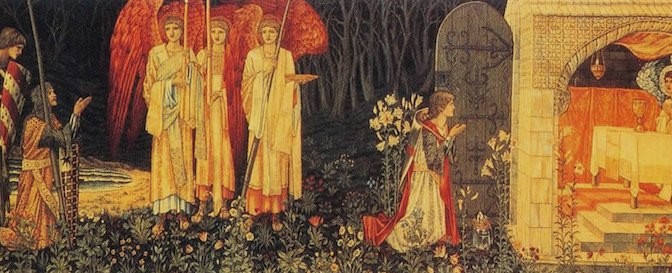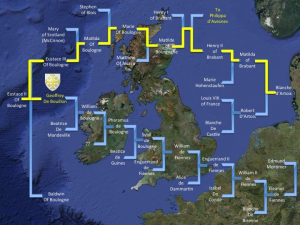 Despite the change of emphasis in Hugh Capet’s claim to the Frankish throne, every member of the male descendents of the Dagobert line saw themselves as potential contenders for the position of “King of all the Franks”. Initially this encompassed the throne of France and also the Holy Roman Empire, an enormous area, all of Western Europe. After “Prince Ursus Revolt” (Sigibert IV) none of them made a meaningful challenge, but they were all treated with great respect. The male lineage continued beyond Geoffrey de Buillion but was finally disrupted when Pharamus of Boulogne failed to produce a male heir.
Despite the change of emphasis in Hugh Capet’s claim to the Frankish throne, every member of the male descendents of the Dagobert line saw themselves as potential contenders for the position of “King of all the Franks”. Initially this encompassed the throne of France and also the Holy Roman Empire, an enormous area, all of Western Europe. After “Prince Ursus Revolt” (Sigibert IV) none of them made a meaningful challenge, but they were all treated with great respect. The male lineage continued beyond Geoffrey de Buillion but was finally disrupted when Pharamus of Boulogne failed to produce a male heir.
His daughter, Sybil married Enguerrand de Fiennes. One of their descendants was Roger Mortimer (see The She Wolf).
Geoffrey’s brother Eustace of Boulogne also failed to produce a male heir and his daughter Matilda married Stephen of Blois, a future King of England. The most famous of the female descents from this line was Blanche d’Artois.
Despite the apparent strength of the Capet claim, The Kings of Europe decided to acquire the “Dagobert Blood” through marriage and thereby strengthen their own claims to thrones they already held. The brother of Saint Louis, Robert of Artois married Matilda of Brabant and their daughter became famous for possessing and distributing the desirable blood line.
What we do not know is how many male descendants simply dropped off the record because they were not the ancestor of someone famous.
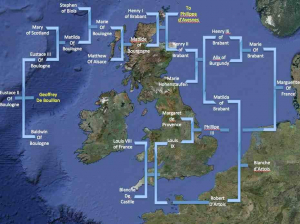 Robert d’Artois’ nephew Phillipe III married Marie of Brabant and their daughter Marguerite of France who married the elderly Edward I of England.
Robert d’Artois’ nephew Phillipe III married Marie of Brabant and their daughter Marguerite of France who married the elderly Edward I of England.
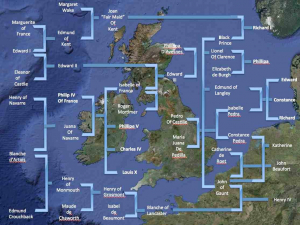 Blanche also married into the English royal family, but the early death of her husband Edmund resulted in a second marriage to Henry of Navarre.
Blanche also married into the English royal family, but the early death of her husband Edmund resulted in a second marriage to Henry of Navarre.
Blanch d’Artois grandaughter Isabelle married another English king, Edward II. Isabelle carried with her into England genealogical knowledge which would distract and torment the English for the next three hundred years.
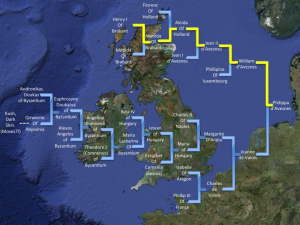 Fig 5 Phillipa d'AsvesnesIsabella’s son, Edward III married Phillipa d’Asvenses, a product of yet another branch of the Dagobert line. Thus three successive English kings married wives with Dagobert credentials.
Fig 5 Phillipa d'AsvesnesIsabella’s son, Edward III married Phillipa d’Asvenses, a product of yet another branch of the Dagobert line. Thus three successive English kings married wives with Dagobert credentials.
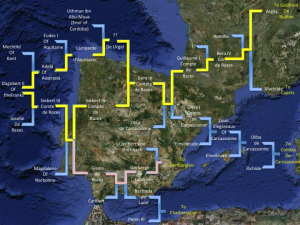 As investigations continued, attention fosusses back on Giselle of Razes. Why had Dagobert selected her as his partner? was it just convenience, a by product of his flight from danger? Or alternatively was there something special about her own bloodline? ( see The Sangreal)
As investigations continued, attention fosusses back on Giselle of Razes. Why had Dagobert selected her as his partner? was it just convenience, a by product of his flight from danger? Or alternatively was there something special about her own bloodline? ( see The Sangreal)
In the later Roman Empire , which had for a long time espoused the concept of “universal citizenship” it had become a requirement for citizens or those aspiring to citizenship to be “ confessing” Christians.
The Visigoths did not comply. They were Arian Christians. Perhaps in retribution, in the areas where they had influence, which still included the majority of the areas south of the Loire and west of the Rhone, they forbade marriages between “Gothia” and other races. The other races in their territories were Romans, Celts, Iberians and Franks.
This embargo was only released in 652. Giselle was born in 658. Her mother was a Visigothic Princess, her father was the grandson of Sigonius, a prefect of Rome. It would have have been one of the first authorized mixed marriages.
It suited those with only the Dagobert line to support their claims to speculate on wether Gizelles parentage, perhaps on both sides, included some form of the “Holy Blood” from a totally different lineage. Combined with the Dagobert heritage this would have created a most powerful conjoin.
As well as the main Dagobert line to Geoffrey de Bouillon, and the Kings of france and england there were multiple lineages through female branches.
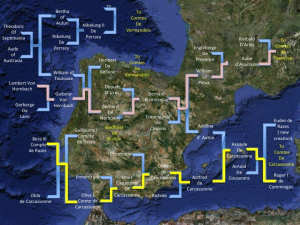 Fig 6 Meanwhile in OccitanAs well as the lineages to Godfoid de Boillon and Hugh capet there was also line to the Comtes de Carcassonne. this line is male decent for many generations but untimately depends on the marriage of Arsinde de Carcassonne to Arnold de Couserans.
Fig 6 Meanwhile in OccitanAs well as the lineages to Godfoid de Boillon and Hugh capet there was also line to the Comtes de Carcassonne. this line is male decent for many generations but untimately depends on the marriage of Arsinde de Carcassonne to Arnold de Couserans.
As families sought to find their own right to rule another source of “holy blood’ was located. In Septimania (see Occitan/ The Trencavel Inheritance when Pepin ejected the moors from Septimania he invited the A Jew from the middle east to help set up Frankish trading partners. This person is known variously as Theodoric of Septimania, Thierry of Autun or Makir Theodoric Aymeri and he is said to have married Pepin’s sister Aude.
The significance of Theodoric is that he is purported to have direct descent from King David, by passing Jesus, a very different concept of “Holy Blood”
This line joins along with the Dagobert line passes to the Comtes of Carcassonne and probably this is where the original Trencavel inheritance comes from.
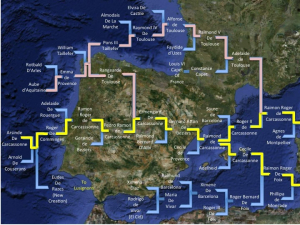 Fig 7 The Trencavels
Fig 7 The Trencavels
The same line extends into the Foix family, though they also have bloodlines from the famous “El Cid” the inspiration for the thrust for Aragonese independence
.
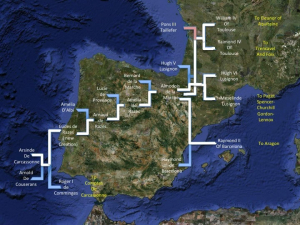 Fig 18 Almodois de la Marche
Fig 18 Almodois de la Marche
The second Creation of a compte de razes, which resulted in the exiled Comptes de Razes to adopt the name of Joinville generates a multiplicity of lines all of which share the Dagobert line heritage, albeit through female links. This distribution of the “holy blood” caused a search for something different, even more exclusive and the search stated with the capet inheritance from Wormsgau.
